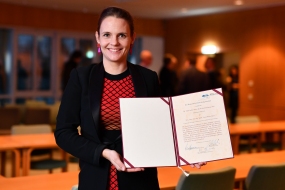Using sound and light for navigating inside the body - Lena Maier-Hein has been awarded the Emil Salzer Prize
When performing minimally invasive surgery, clinicians need to have imaging information from inside the body for spatial orientation and in order to differentiate malignant tissue from healthy tissue. Novel imaging methods based on sound and light provide additional imaging information that goes far beyond the images that a normal endoscopic camera can provide. Lena Maier-Hein from the German Cancer Research Center (DKFZ) now receives the 2016 Emil Salzer Prize for enhancing these methods.
Minimally invasive surgery, also called keyhole surgery, has become extremely common in many areas of medicine, such as in gynecology and abdominal surgery. When performing minimally invasive surgery, physicians are faced with two major challenges: First, surgeons need to know precisely how to insert endoscopic instruments into a target region without injuring nearby organs. Second, they need to differentiate between malignant tissue and healthy tissue. If this differentiation cannot be reliably made, the tumor may recur.
Maier-Hein addresses precisely these challenges in her research and has now been awarded the Emil Salzer Prize. Using combined expertise in computer sciences, physics and medicine, the award winner has developed innovative methods for more precision and safety in the planning of computer-navigated surgery.
So far, physicians have illuminated the target area inside the body during minimally invasive surgery using an endoscopic camera that uses white light. This type of illumination delivers only poor contrasts and little depth of vision. Lena Maier-Hein has combined this standard imaging with an emerging technology called multispectral optical and photoacoustic imaging.
Photoacoustic methods produce images based on information that is delivered by sound. The sound waves are produced when laser impulses are delivered into tissue where some of the light energy is absorbed and converted into heat. The heat leads to minimal expansion of the tissue. This produces ultrasonic emission signals that can be detected and translated into an image by a computer. Each type of tissue responds in a different manner to the laser impulses, resulting in different sound signals.
Maier-Hein and her team combined multispectral optical and photoacoustic imaging with methods of machine learning in order to capture relevant tissue parameters - non-invasively and without exposure to radiation. The scientists use the signals to reconstruct important characteristics of the tissues under examination. This enables physicians to assess not only the three-dimensional surface of organs, but additionally the details that are hidden beneath, such as the structure of blood vessels, blood supply and oxygen saturation in the target region. These are important clues about potential malignant tissue alterations.
During surgery, the surgeon has images of the organ and tissue surfaces plus the additional information provided by the imaging technology. The individual patient’s anatomy, which is calculated and visualized in 3D based on prior CT and MRI scans, is superimposed on these images.
In collaboration with Heidelberg University Hospital, Maier-Hein and her team are testing and evaluating the innovative method in computer-assisted endoscopic examinations of the bowel and stomach. Enhancements in these commonly performed surgical procedures would benefit many people, for example in colorectal cancer screening programs.
Lena Maier-Hein, born in 1980, studied computer sciences at the Karlsruhe Institute of Technology (KIT) and at the Imperial College in London and attained her qualification to give lectures (‘Habilitation’) at Heidelberg University in 2013. Since 2009, she has been pursuing research as a post-doc at the DKFZ, where she has been leading an independent junior research group since 2012 and, since 2016, the Division of Computer-Assisted Medical Interventions. Maier-Hein has already been distinguished with several science awards including the 2013 Heinz Maier Leibniz Award of the German Research Foundation (DFG). In 2015, she received a Starting Independent Researcher Grant from the European Research Council (ERC).
On behalf of Baden-Wuerttemberg’s Ministry of Science, Research and the Arts, the DKFZ has awarded the Dr. Emil Salzer Prize since 1970. It was established by Emil Salzer, a physician and scientist from Reutlingen, Germany. Salzer left his bequest to the State of Baden-Wuerttemberg under the condition that the proceeds be used to support cancer research. The prize currently comprises €5000.
A picture is available at:
http://www.dkfz.de/de/presse/pressemitteilungen/2016/bilder/Salzer-Preis-UA1-7404.jpg
Caption: Priv.-Doz. Dr. Lena Maier-Hein was awarded the 2016 Dr. Emil Salzer Prize
Note on use of images related to press releases
Use is free of charge. The German Cancer Research Center (Deutsches Krebsforschungszentrum, DKFZ) permits one-time use in the context of reporting about the topic covered in the press release. Images have to be cited as follows: “Source: Uwe Anspach, DKFZ”.
Distribution of images to third parties is not permitted unless prior consent has been obtained from DKFZ’s Press Office (phone: ++49-(0)6221 42 2854, E-mail: presse@dkfz.de). Any commercial use is prohibited.
With more than 3,000 employees, the German Cancer Research Center (Deutsches Krebsforschungszentrum, DKFZ) is Germany’s largest biomedical research institute. DKFZ scientists identify cancer risk factors, investigate how cancer progresses and develop new cancer prevention strategies. They are also developing new methods to diagnose tumors more precisely and treat cancer patients more successfully. The DKFZ's Cancer Information Service (KID) provides patients, interested citizens and experts with individual answers to questions relating to cancer.
To transfer promising approaches from cancer research to the clinic and thus improve the prognosis of cancer patients, the DKFZ cooperates with excellent research institutions and university hospitals throughout Germany:
The DKFZ is 90 percent financed by the Federal Ministry of Education and Research and 10 percent by the state of Baden-Württemberg. The DKFZ is a member of the Helmholtz Association of German Research Centers.


